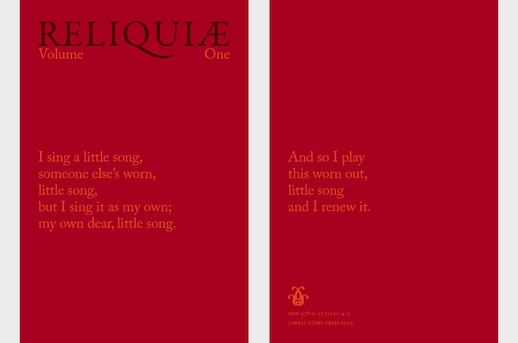Reliquiae (volume one)
Eds. Autumn Richardson and Richard Skelton
Corbel Stone Press
May 2013
A review by Rob St. John.
There’s an Inuit song from Western Greenland on the cover of the first volume of Reliquiae, a new journal of poetry, short fiction, non-fiction, translations and visual art edited by Autumn Richardson and Richard Skelton of Corbel Stone Press. It goes:
I sing a little song,
someone else’s worn
little song,
but I sing it as my own;
my own dear little song
And so I play
this worn out little song
and I renew it.
It’s a beautiful song, and an apt introduction to a volume devoted to questioning, reinterpreting and renewing our relationship with the environment through art. Richardson and Skelton are skilled curators of prose, paintings and poetry that span folklore, fiction, ecology and philosophy, assembling constellations of esoteric information with a keen curiosity. Collections of waylaid tales and notes from the margins are set throughout this beautifully produced book in short chapters: stratified layers of memory and shimmering reflections on the littoral truth(s) of the natural world.
Noor de Winter’s piece ‘Landscape as the Origin of Music’ presents short passages from her ongoing translations of Fluß ohne Ufer (Shoreless River), an early 20th century novel by German expressionist writer Hans Henry Jahnn. Fluß ohne Ufer follows composer Gustav Anais Horn’s meditations on the nature of music and landscape, as he takes compositional inspiration from the brittle grooves and pockmarks on birch bark. The rough peaks and troughs of Braille-like bark are translated into song by Anais’ pianola reel: fingers and keys trace new readings of the landscape through sound.
de Winter’s notes accompanying these translations are illuminating in their understated perception, and might well describe the practice of many individuals working at the intersection of art and the environment: ‘When landscape is the source of an art, there must be a special relationship between place and artist… The task of the artist might therefore be to immerse himself in that environment – to become accustomed to what it actually is, so that it might reveal its particular melody’.
Reliquiae’s fragmented surveys of people, places and landscapes in the high northern hemisphere – taking in Inuit songs, Manx folklore, Canadian oil paintings and Cumbrian cryptozoology – rarely stray from a path of curious animism. Human and non-human blur in the ecstatic northern light: a frozen magical realism. WB Yeats’ 1914 story ‘The Wisdom of the King’ tells of the uneasy progress of a royal son who sprouts grey hawk feathers amongst his hair. Richard Jefferies’ ‘Birds Climbing in the Air’ (1899) charts the (meta)physical mechanics of a hawk in flight, a precursor JA Baker’s lauded 1967 study of avian ritual, obsession and solace, The Peregrine.
The closing contribution to the book, Mark Valentine’s ‘The Other Salt’ is perhaps the most enjoyable of the collection: an elegiac short story set on an anonymous French shore. It tracks the routes through the flat salt marshes taken by an unnamed narrator in search of a mysterious mineral ‘the other salt’. Valentine’s precise, lyrical prose distils an essence of the edgeland – half-known, neglected and mapped by uncertain cartographies – haunted, perhaps, by the spectres of MR James’ and Arthur Machen’s liminal explorations between the real and the unreal.
As you might expect from Richardson and Skelton’s previous output though Corbel Stone Press, Reliquiae is a beautiful object: the paper, typography and typesetting betray a working practice based on an attention to detail. Skelton’s written contribution ‘With His Coat So Gray’ – inspired by John Woodcock Graves’ ode to John Peel – a north-country huntsman – in Sidney Gilpin’s 1874 Songs and Ballads of Cumberland and the Lake Country – investigates the history of the Cumbrian fell-fox. Whether this creature existed as a separate species to the common red fox is uncertain, but the line ‘D’ye ken John Peel with his coat so gray?’ suggests that the huntsman wore the coat of a dull-coloured specimen. As Skelton shows, similarly huge, grey foxes litter early 20th century histories of hunting in Cumbria.
Skelton’s placemaking explorations of uncertain memory and the residues of a forgotten (or perhaps imagined) animal form a central thematic core to the book. Reliquiae is the Latin word for ‘remains’, and Richardson and Skelton’s sensitive, intelligent curation of these trace remains at the intersection of art, the natural world, folklore and the supernatural make for a collection that is likely to itself endure. As Skelton writes: ‘It reminds me that there are some things which cannot be contained or kept chained. That despite capture – and extinction – essence always escapes, eludes, confounds. All that remains in the hands is scent. A residue. A reminder.’
